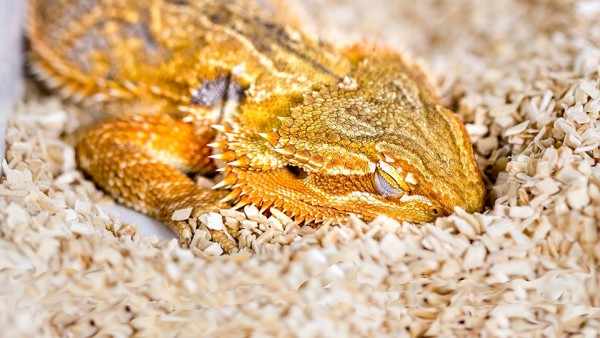By Ana Verayo, | April 29, 2016

A sleeping bearded dragon lizard apparently share the same sleep cycles as mammals and humans.
In a new study, sleep patterns of reptiles are revealed suggesting that their sleep states are also similar to birds and mammals, including humans. Scientists now say that their sleep patterns also involve rapid eye movement (REM) during their sleep patterns along with sleep wave patterns. This evolved for 300 million years, that was carried from reptilian ancestors to modern day lizards, and also, dinosaurs, that are also believed to dream in their sleep.
Like Us on Facebook
In this new study, researchers studied five Australian bearded dragons and determined what reptiles mostly dream about. According to neuroscientist Gilles Laurent from the Max Planck Institute for Brain Research in Germany, this can be speculated as a loose definition of dreaming, where reptilian dreams could involve insects or a place where there are good insects or an aggressive male etc.
As humans experience REM sleep, blood pressures and heart rates will rise where eyes can move rapidly and the muscles in the limbs become immobilized similar to a temporary paralysis, indicating a dream production state. During slow wave sleep however, this is translated as deep sleep where there is little or no occurrence of dreams.
During the experiments, researchers implanted probes inside the Australian bearded dragons' brains to measure their sleep activity, more specifically their electrophysiological states. For humans, there are four or five REM and long slow wave sleep cycles occurring every night. The test reptiles on the other hand had demonstrated a surprising 350 sleep cycles, lasting for 80 seconds each.
According to professor of neural systems, Thanos Siapas of Caltech, this study has been a truly groundbreaking one, providing crucial insight about the architecture of sleep. Data from the analysis of these results are remarkable and just as compelling, suggesting the ancient origins of the two alternating cycles of the stages of sleep.
How the evolution of sleep first evolved remains unknown, but further research can support this new study regarding sleep stages and cycles that are similar in animals and humans.This new study is published in the journal, Science.
-
Use of Coronavirus Pandemic Drones Raises Privacy Concerns: Drones Spread Fear, Local Officials Say

-
Coronavirus Hampers The Delivery Of Lockheed Martin F-35 Stealth Fighters For 2020

-
Instagram Speeds Up Plans to Add Account Memorialization Feature Due to COVID-19 Deaths

-
NASA: Perseverance Plans to Bring 'Mars Rock' to Earth in 2031

-
600 Dead And 3,000 In The Hospital as Iranians Believed Drinking High-Concentrations of Alcohol Can Cure The Coronavirus

-
600 Dead And 3,000 In The Hospital as Iranians Believed Drinking High-Concentrations of Alcohol Can Cure The Coronavirus

-
COVID-19: Doctors, Nurses Use Virtual Reality to Learn New Skills in Treating Coronavirus Patients







